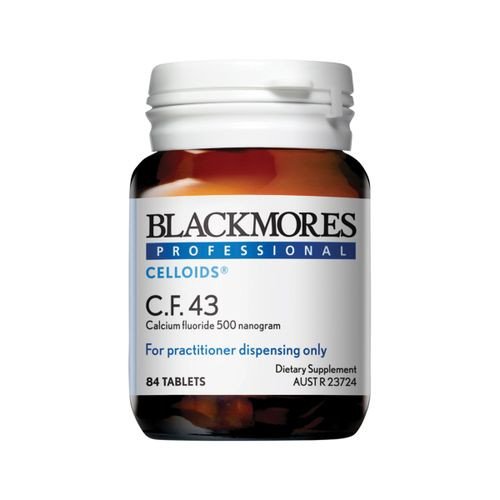When prescribed by a healthcare professional C.F.43 is generally well tolerated at the recommended dose, and may be prescribed for infants, children, pregnant and lactating women, and the elderly.The easy-to-swallow tablet can be halved or crushed to facilitate low-dose prescribing for infants and children.Prescribing InformationCalcium fluoride supports the strength and integrity of bones and teeth and is also found in many types of connective tissue, where it aids elasticity and flexibility. Calcium has a role in bone development and integrity. When fluoride is incorporated into bone it is found with calcium.Connective tissue: Calcium fluoride is widely distributed in connective tissue (for example in cartilage, skin, muscles, nerves, valves and sphincters), where it is important for strength, flexibility and elasticityBone: In new bone, calcium and fluoride come together to form fluorapatite, in which the hydroxyl ion in the calcium phosphate compound hydroxyapatite is replaced by fluoride ions in bone formation, creating a complex that is believed to be more resistant to bone resorption than hydroxyapatite.Teeth: The fluoroapatite crystal, composed of calcium and fluoride is also present in tooth enamel, where its stable structure gives the teeth tremendous strength and enables them to resist acid and caries.
When prescribed by a healthcare professional C.F.43 is generally well tolerated at the recommended dose, and may be prescribed for infants, children, pregnant and lactating women, and the elderly.The easy-to-swallow tablet can be halved or crushed to facilitate low-dose prescribing for infants and children.Prescribing InformationCalcium fluoride supports the strength and integrity of bones and teeth and is also found in many types of connective tissue, where it aids elasticity and flexibility. Calcium has a role in bone development and integrity. When fluoride is incorporated into bone it is found with calcium.Connective tissue: Calcium fluoride is widely distributed in connective tissue (for example in cartilage, skin, muscles, nerves, valves and sphincters), where it is important for strength, flexibility and elasticityBone: In new bone, calcium and fluoride come together to form fluorapatite, in which the hydroxyl ion in the calcium phosphate compound hydroxyapatite is replaced by fluoride ions in bone formation, creating a complex that is believed to be more resistant to bone resorption than hydroxyapatite.Teeth: The fluoroapatite crystal, composed of calcium and fluoride is also present in tooth enamel, where its stable structure gives the teeth tremendous strength and enables them to resist acid and caries.



 Gain access now
Gain access now